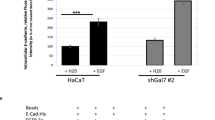Summary
Expression of E (epithelia) and P (placental) cadherin cell adhesion molecules was examined immunohistochemically using human developing skin. In adult skin, E-cadherin was expressed on cell surfaces of whole epidermal layers including skin appendages, whereas P-cadherin was expressed only on those of basal layers and the outer layers of skin appendages, which was consistent with the compartment of proliferating cells. In fetal skin, while the patterns of E- and P-cadherin expression were generally similar to those in the adult, P-cadherin temporarily showed a unique spatiotemporal expression pattern in developing sweat ducts. During this stage, the expression of P-cadherin accumulated in the epidermal ridges and showed a discrepancy with the compartment of proliferating cells. These results suggest that the expression of P-cadherin is spatiotemporally controlled, and may be closely related to the segregation of basal layers as well as to the arrangement of epidermal cells into eccrine sweat ducts, but is not closely related to cell proliferation.
Similar content being viewed by others
References
Chuong C, Edelman GM (1985) Expression of cell-adhesion molecules in embryonic induction. I. Morphogenesis of nestling feathers. J Cell Biol 101: 1009–1026
Chuong C, Edelman GM (1985) Expression of cell-adhesion molecules in embryonic induction. II. Morphogenesis of adult feathers. J Cell Biol 101: 1027–1043
Gerdes J, Schwab U, Lemke H, Stein H (1983) Production of a mouse monoclonal antibody reactive with a human nuclear antigen associated with cell proliferation. Int J Cancer 31: 13–20
Gerdes J, Lemke H, Baisch HH, Schwab U, Stein H (1984) Cell cycle analysis of a cell proliferation-associated human nuclear antigen defined by the monoclonal antibody Ki-67. J Immunol 133: 1710–1715
Hashimoto K (1970) The ultrastructure of the skin of human embryos. V. The hair germ and perifollicular mesenchymal cells; hair germ-mesenchymal interaction. Br J Dermatol 83: 167–176
Hashimoto K (1970) The ultrastructure of the skin of human embryos. VI. The formation of the intradermal hair canal. Dermatologica 141: 49–54
Hashimoto K, Gross BG, Lever WF (1966) The ultrastructure of the skin of human embryos. II. The formation of intradermal portion of the eccrine sweat duct and of the secretory segment during the first half of embryonic life. J Invest Dermatol 46: 513–529
Hatta K, Okada TS, Takeichi M (1985) A monoclonal antibody disrupting calcium-dependent cell-cell adhesion of brain tissues: possible role of its target antigen in animal pattern formation. Proc Natl Acad Sci USA 82: 2789–2793
Hatta K, Takagi S, Fujisawa H, Takeichi M (1987) Spatial and temporal expression pattern of N-cadherin cell adhesion molecules correlated with morphogenetic processes of chicken embryos. Dev Biol 120: 215–227
Hirai Y, Nose A, Kobayashi S, Takeichi M (1989) Expression and role of E- and P-cadherin adhesion molecules in embryonic histogenesis. II. Skin morphogenesis. Development 105: 271–277
Holbrook KA, Odland GF (1978) Structure of the human fetal canal and initial hair eruption. J Invest Dermatol 71: 385–390
Navarro P, Gómez M, Pizarro A, Gamallo C, Quintanilla M, Cano A (1991) A role for the E-cadherin cell-cell adhesion molecule during tumor progression of mouse epidermal carcinogenesis. J Cell Biol 115: 517–533
Nose A, Takeichi M (1986) A novel cadherin adhesion molecule: its expression pattern associated with implantation and organogenesis of mouse embryos. J Cell Biol 103: 2649–2658
Sasaki K, Murakami T, Kawasaki M, Takahashi M (1987) The cell cycle associated change of the Ki-67 reactive nuclear antigen expression. J Cell Physiol 133: 578–584
Shimoyama Y, Hirohashi S, Hirano S, Noguchi M, Shimosato Y, Takeichi M, Abe O (1989) Cadherin cell-adhesion molecules in human epithelial tissues and carcinomas. Cancer Res 49: 2128–2133
Takeichi M (1988) The cadherins: cell-cell adhesion molecules controlling animal morphogenesis. Development 102: 639–655
Takeichi M, Hatta K, Nagafuchi A (1985) Selective cell adhesion mechanism: role of the calcium-dependent cell adhesion system. In: Edelmann GM (ed) Molecular determinants of animal form. Liss, New York, pp 223–233
Tawnes PL, Holtfreter J (1955) Directed movements and selective adhesion of embryonic amphibian cells. J Exp Zool 128: 53–120
Author information
Authors and Affiliations
Rights and permissions
About this article
Cite this article
Fujita, M., Furukawa, F., Fujii, K. et al. Expression of cadherin cell adhesion molecules during human skin development: morphogenesis of epidermis, hair follicles and eccrine sweat ducts. Arch Dermatol Res 284, 159–166 (1992). https://doi.org/10.1007/BF00372710
Received:
Issue Date:
DOI: https://doi.org/10.1007/BF00372710




